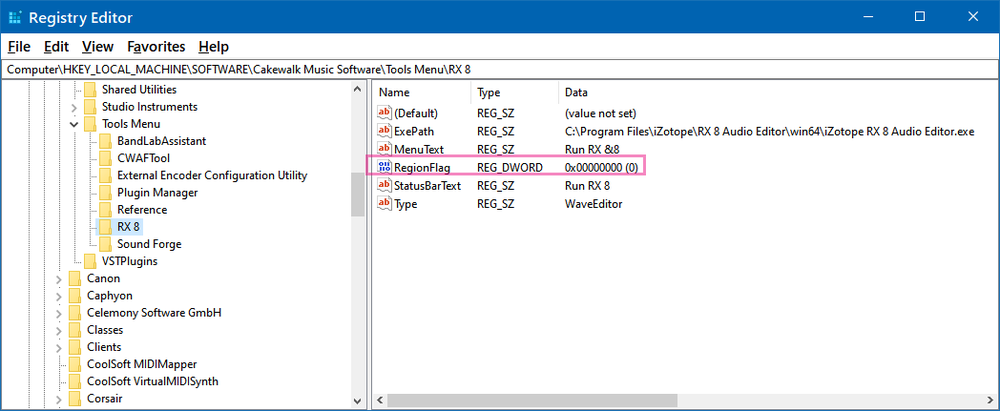-
Posts
9,681 -
Joined
-
Last visited
-
Days Won
27
Posts posted by scook
-
-
41 minutes ago, Jim Hurley said:
My upgrade price from 14 Pro was $99. I think that is a bit high for the new features, but not outrageous.
SF upgrades have always been expensive.
I was pleasantly surprised when Humble Bundle offered SF12 Pro for $20 (with a bunch of other stuff).
Eagerly awaiting their next SF Pro deal.
Most of what I used SF for is now handled by iZotope RX7 but still occasionally use SF.
-
 1
1
-
-
Yeah, I recall that from when the first version of Tools Editor was developed.
IIRC, old versions of Audacity worked, newer versions (around the time of that post) did not.
Since that time no one has reported success using Audacity.
Just because no one has reported success is not the final word on the subject.
Of course, this has nothing to do with the tool I wrote.
The object of my exercise was to provide a better way to add entries to the tools section of the Utility menu.
SONAR/Cakewalk are launching the program and passing the arguments.
I have yet to read about an audio editor failing to run properly when setup according the information provided by Cakewalk.
-
Audacity is a DAW.
DAWs are designed to work with projects containing multiple audio files so they are not setup to take a single wav file as an argument on their command line. Some DAWs have extensive audio editing features but they are intended to be called from inside the DAW,
Audio editors are designed to work with individual files. As a result, it it common for them to support adding a wav file to their command line.
There are plenty of no cost and low cost audio editors.
-
 1
1
-
-
7 minutes ago, aidan o driscoll said:
or with the with the very good free audio editor called AUDACITY.
Are you sure about this?
I don't use AUDACITY but AFAIK it does not support passing wav files on the command line.
At least no one using AUDACITY has ever report successfully using a newer version of it as a WaveEditor in SONAR/CbB.
Without command line support, there is no convenient way to pass data between CbB and another program using the CbB WaveEditor feature.
-
 1
1
-
-
18 hours ago, Jim Hurley said:
One more thing, it is easy to forget about the RegionFlag setting for RX8 when you use it in the Tools Menu:
http://forum.cakewalk.com/Error-Message-with-iZotope-RX-3-as-WaveEditor-in-SONAR-X3-m3089217.aspx
that thread and Noel's replies in a similar thread resulted in my developing Tools Editor.
available on my Google page
a new version of it and the rest of the tools should be out soon
-
 2
2
-
 1
1
-
-
ARA is not at play here.
The plug-in is instantiated the old way before Region FX.
I would have to experiment with Melodyne in the FX rack to see what is possible.
The standard advice is bounce Melodyne clips ASAP.
Melodyne is not intended to be left in a project like a regular effect.
-
More info about Snap Offset from the clip inspector help
-
 1
1
-
-
3 hours ago, MARTIN NICKLESS said:
Hi could somebody put this in English please as I’m not familiar with the jargon you’re using what are envelopes thank you so much
Envelopes are the visual representation of automation used to control various aspects of the data and performance in the DAW.
There is a large amount of information in the documentation about automation and how to use envelopes. There is even a glossary of terms in the documentation. For example,
QuoteEnvelopes
Reflects the changes in value for a specified parameter (volume, for example) over a period of time. Also refers to the graph of the change—same as vector.
See Automation.
I am sure there are quite a few videos on the subject too. Youtube is pretty good resource for them.
-
It is still there and in the documentation.
When documented features appear to be missing, the first thing to check is the Workspace setting.
If the Workspace is OK review the click behavior settings in the Track View options menu for audio clip double-click
-
 2
2
-
-
4 minutes ago, mettelus said:
Those 3 synths are $773 (regular price)
The 3 synths I don't have are $653 retail
I already own the full version of MSoundFactory.
The three synths I get with the upgrade are MDrummer, MPowerSynth and MSoundFactoryLE.
Not sure what I would do with MSoundFactoryLE or why it is even mentioned in the upgrade offer.
MComplete did not exist when I bought the MTotalBundle.
-
Is CBSProductsInfo.dll a VST plug-in?
It does not sound like one.
The scanner should only be used with folders containing VST plug-ins.
Scanning random dlls can be a problem.
May want to review the scan path in preferences.
-
 1
1
-
-
1 minute ago, Bapu said:
TBH I hardly use what I have
A novel bit of reasoning
-
Yes, price is part of discount computation.
This is why my upgrade to the MComplete bundle is $547.
For $547, I get MDrummer, MPowerSynth and MSoundFactoryLE and any thing else they may add at a future date (assuming they do not add another tier above MComplete).
When I purchased MTotalBundle, there was no MComplete and the only synth was MDrummer and the lite version of MDrummer.
Some time after releasing MPowerSynth, Melda renamed MTotalBundle to MTotalFXBundle and added MComplete.
-
Could this be related to your use of Melodyne in the FX rack?
Remember, once a track is transferred into Melodyne, the audio originates from the plug-in NOT the clip in the track.
As I noted in your original post..
QuoteRender Melodyne to restore the regular signal flow.
-
You will either need to modify the split notes to tracks CAL to group pitches rather then placing them in individual tracks
or
duplicate the MIDI clips and delete/filter the unwanted data from each track.
There are several of ways to delete ranges of notes such as selecting the notes on the keyboard then hitting the DELETE key in the PRV.
Alternately filter each voice using the MIDI Event Filter MFX. Once a key range is defined, save it as a preset for future use.
The filter may be left in the MFX rack or applied to destructively remove the unwanted data in the track.
If you prefer to keep all the notes on one track and distribute them to other tracks route the MIDI track through a plug-in that will echo the data such as one of the Code FN42 plug-ins MIDIChFilter, NoteMapper or VeloScaler. Then use the FN42 plug-in as the input to the "voice" tracks. Add the MIDI Event Filters for each voice on the appropriate track.
or
use a drum map. A drum map may route each pitch or groups of pitches to a different synth.
-
Assuming the clip was transferred to Melodyne, the clip shown in the DAW is no longer the source of the audio.
The audio is originating in Melodyne.
Any processing happening before the Melodyne plug-in is ignored as I tried to explain here
-
Deselect "Enable MIDI Output if Available" in the Insert Soft Synths Options dialog
-
 1
1
-
-
Nothing in my comment adds or takes away from the reviews.
Reviews don't mean much to those who do not have the plug-in, if the product is no longer available.
-
it is odd the conversation has gone on so long.
While the CA-2A is a decent plug-in, the only thing unique about it is the PC format.
For those who did not get a copy, the best course of action today is look to another manufacturer for a similar product.
-
Gibson still owns CA-2A. They did not give up their rights to the product when they shut down Cakewalk. They could start selling the product again, if they wanted to do so. There is no legitimate way to acquire new licenses or share licenses for CA-2A, SONAR or any products made by Cakewalk. unless Gibson allows it.
BandLab purchased the source code for Cakewalk products from Gibson and could use it to create their version of CA-2A just like they did with SONAR.
-
 2
2
-
-
Uninstall does not remove user data. The projects will not be touched.
Run the Uninstall option from the menu in BA

-
 1
1
-
-
The MS GS Wavetable synth is an external synth and needs to be treated like any other hardware synth.
AFAIK, its output is hard coded to use the default Windows audio output.
TTS-1 is a GM synth and most find it easier to work with it instead of dealing with the MS synth chip.
If no MIDI output is enabled in Cakewalk preferences when opening a MIDI file, Cakewalk automatically sets up TTS-1 to play the file.
-
3 db increase often involves summing two channels into one.
Examples are given in the documentation
My guess is the entire mix export is stereo so this summing does not occur.
Based on the plug-in dot pattern, the plug-ins in the FX rack are stereo so even through the clips are mono, they are being processed in stereo.
Exporting the track as mono causes processed signal (now stereo) to be summed.
-
 2
2
-
 2
2
-
-
The "transfer method" (IOW using Melodyne as a regular plug-in) copies the clip into the Melodyne environment, then Melodyne processes and plays back the processed clip. The clip shown in the track is no longer used.
Anything added before the Melodyne plug-in will not have any effect because the audio is originating from the Melodyne instance using the copy it made during the transfer process.
Render Melodyne to restore the regular signal flow.
Using Melodyne as a Region FX does not use the transfer process. This is what ARA (Audio Random Access) is all about. It reads and processes data very early in the regular DAW signal flow.
-
 1
1
-




Meldaproduction reduce the price of all of their bundles by 60% this weekend only.
in Deals
Posted
Is a per-plug-in setting.
The plug-ins must be enabled in order for the 2x button in the transport module to have any effect.
The upsample settings are in the upper left window decoration above the plug-in UI.
FWIW, I wrote a tool to manage CbB upsample settings.
Use either the built-in plug-in or CbB upsample settings. Do not use both on the same plug-in.